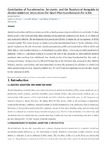Please use this identifier to cite or link to this item:
http://lib.hpu.edu.vn/handle/123456789/22727Full metadata record
| DC Field | Value | Language |
|---|---|---|
| dc.contributor.author | Patkar, Omkar L. | en_US |
| dc.contributor.author | Belmer, Arnauld | en_US |
| dc.contributor.author | Bartlett, Selena E. | en_US |
| dc.date.accessioned | 2016-08-02T08:13:36Z | |
| dc.date.available | 2016-08-02T08:13:36Z | |
| dc.date.issued | 2016 | en_US |
| dc.identifier.isbn | 978-953-51-2492-4 | en_US |
| dc.identifier.other | HPU3160497 | en_US |
| dc.identifier.uri | https://lib.hpu.edu.vn/handle/123456789/22727 | |
| dc.description.abstract | Alcohol use disorders (AUDs) constitute one of the 10 leading causes of preventable deaths worldwide. To date, there are only a few Food and Drug Administration (FDA)‐approved medications for AUDs, all of which are only moderately effective. The development of improved and effective strategies for the management of AUDs is greatly needed. This review focuses on understanding the neurobiological basis of alcohol addiction with a special emphasis on the role of serotonin (5‐hydroxytryptamine, 5‐HT) and noradrenaline (NE) in AUDs and sheds light on their complex interplay in the basolateral amygdala (BLA)––a brain region widely implicated in addiction. There is a significant evidence to support the role of the amygdala in stress‐induced negative emotional states resulting from withdrawal from alcohol. in fact, it has been hypothesized that this leads to craving and relapse. Dysregulation of 5‐HT and NE signaling in the BLA have been proposed to alter affective behavior, memory consolidation, and most importantly increase the propensity for addiction to alcohol and other common drugs of abuse. Improving deficits in 5‐HT and NE receptor signaling may provide ideal targets for the treatment of AUDs. | en_US |
| dc.format.extent | 10 p. | en_US |
| dc.format.mimetype | application/pdf | |
| dc.language.iso | en | en_US |
| dc.publisher | INTECH Open Access Publisher | en_US |
| dc.subject | Medicine | en_US |
| dc.subject | Addiction | en_US |
| dc.subject | Alcohol use disorders | en_US |
| dc.subject | Noradrenaline | en_US |
| dc.subject | Serotonin | en_US |
| dc.subject | Basolateral amygdalaMedicine | en_US |
| dc.subject | Addiction | en_US |
| dc.subject | Alcohol use disorders | en_US |
| dc.subject | Noradrenaline | en_US |
| dc.subject | Serotonin | en_US |
| dc.subject | Basolateral amygdalaMedicine | en_US |
| dc.subject | Addiction | en_US |
| dc.subject | Alcohol use disorders | en_US |
| dc.subject | Noradrenaline | en_US |
| dc.subject | Serotonin | en_US |
| dc.subject | Basolateral amygdala | en_US |
| dc.title | Recent Advances in Drug Addiction Research and Clinical Applications. Chapter 5: Contribution of Noradrenaline, Serotonin, and the Basolateral Amygdala to Alcohol Addiction: Implications for Novel Pharmacotherapies for AUDs | en_US |
| dc.type | Book | en_US |
| dc.size | 963KB | en_US |
| dc.department | Education | en_US |
| Appears in Collections: | Education | |
Files in This Item:
| File | Description | Size | Format | |
|---|---|---|---|---|
| 32_RecentAdvancesinDrugAddictionResearchandClinicalApplications_ch5.pdf Restricted Access | 962.89 kB | Adobe PDF |  View/Open Request a copy |
Items in DSpace are protected by copyright, with all rights reserved, unless otherwise indicated.
